Queensford College BSBMKG507: Market Trend Analysis Assignment
VerifiedAdded on 2022/09/28
|34
|11087
|19
Homework Assignment
AI Summary
This document presents an assessment guide for the BSBMKG507 unit, focusing on interpreting market trends and developments, at Queensford College. The assessment includes questions and answers, key term definitions, a case study, and a work-based project, all designed to evaluate the student's ability to analyze market data, identify trends, and report findings. The assignment requires students to demonstrate skills in statistical and qualitative analysis, forecasting, and report writing. It covers various aspects of trend analysis, including preparing for analysis, identifying critical decision points, and addressing variations and their business impacts. The document also provides details on the assessment process, including evidence gathering, resources, and re-assessment policies. It emphasizes the importance of original work and provides links to relevant companion volumes.
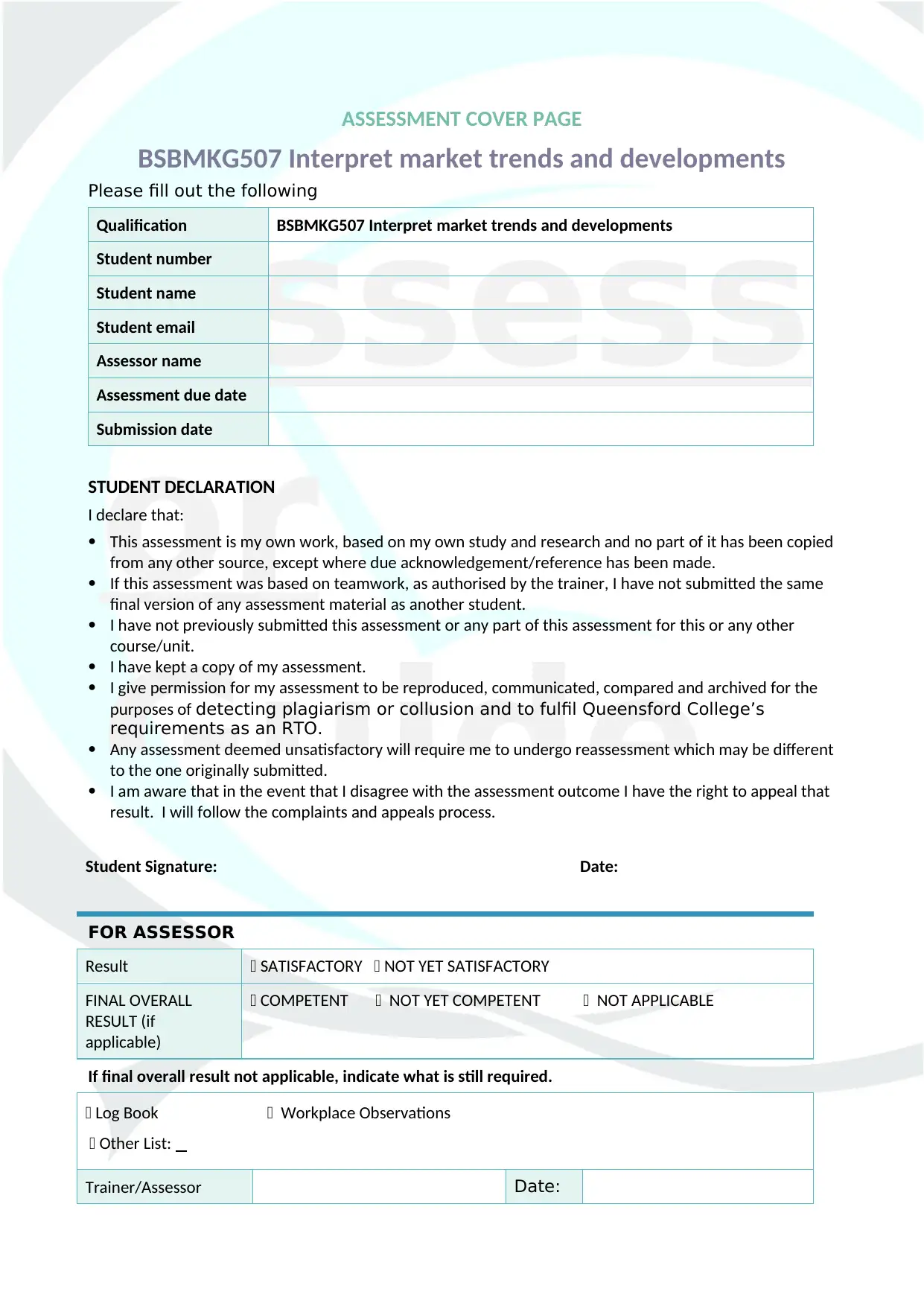
Assess
or
Guide
ASSESSMENT COVER PAGE
BSBMKG507 Interpret market trends and developments
Please fill out the following
Qualification BSBMKG507 Interpret market trends and developments
Student number
Student name
Student email
Assessor name
Assessment due date
Submission date
STUDENT DECLARATION
I declare that:
This assessment is my own work, based on my own study and research and no part of it has been copied
from any other source, except where due acknowledgement/reference has been made.
If this assessment was based on teamwork, as authorised by the trainer, I have not submitted the same
final version of any assessment material as another student.
I have not previously submitted this assessment or any part of this assessment for this or any other
course/unit.
I have kept a copy of my assessment.
I give permission for my assessment to be reproduced, communicated, compared and archived for the
purposes of detecting plagiarism or collusion and to fulfil Queensford College’s
requirements as an RTO.
Any assessment deemed unsatisfactory will require me to undergo reassessment which may be different
to the one originally submitted.
I am aware that in the event that I disagree with the assessment outcome I have the right to appeal that
result. I will follow the complaints and appeals process.
Student Signature: Date:
FOR ASSESSOR
Result SATISFACTORY NOT YET SATISFACTORY
FINAL OVERALL
RESULT (if
applicable)
COMPETENT NOT YET COMPETENT NOT APPLICABLE
If final overall result not applicable, indicate what is still required.
Log Book Workplace Observations
Other List:
Trainer/Assessor Date:
or
Guide
ASSESSMENT COVER PAGE
BSBMKG507 Interpret market trends and developments
Please fill out the following
Qualification BSBMKG507 Interpret market trends and developments
Student number
Student name
Student email
Assessor name
Assessment due date
Submission date
STUDENT DECLARATION
I declare that:
This assessment is my own work, based on my own study and research and no part of it has been copied
from any other source, except where due acknowledgement/reference has been made.
If this assessment was based on teamwork, as authorised by the trainer, I have not submitted the same
final version of any assessment material as another student.
I have not previously submitted this assessment or any part of this assessment for this or any other
course/unit.
I have kept a copy of my assessment.
I give permission for my assessment to be reproduced, communicated, compared and archived for the
purposes of detecting plagiarism or collusion and to fulfil Queensford College’s
requirements as an RTO.
Any assessment deemed unsatisfactory will require me to undergo reassessment which may be different
to the one originally submitted.
I am aware that in the event that I disagree with the assessment outcome I have the right to appeal that
result. I will follow the complaints and appeals process.
Student Signature: Date:
FOR ASSESSOR
Result SATISFACTORY NOT YET SATISFACTORY
FINAL OVERALL
RESULT (if
applicable)
COMPETENT NOT YET COMPETENT NOT APPLICABLE
If final overall result not applicable, indicate what is still required.
Log Book Workplace Observations
Other List:
Trainer/Assessor Date:
Paraphrase This Document
Need a fresh take? Get an instant paraphrase of this document with our AI Paraphraser

Assess
or
Guide
Signature
or
Guide
Signature
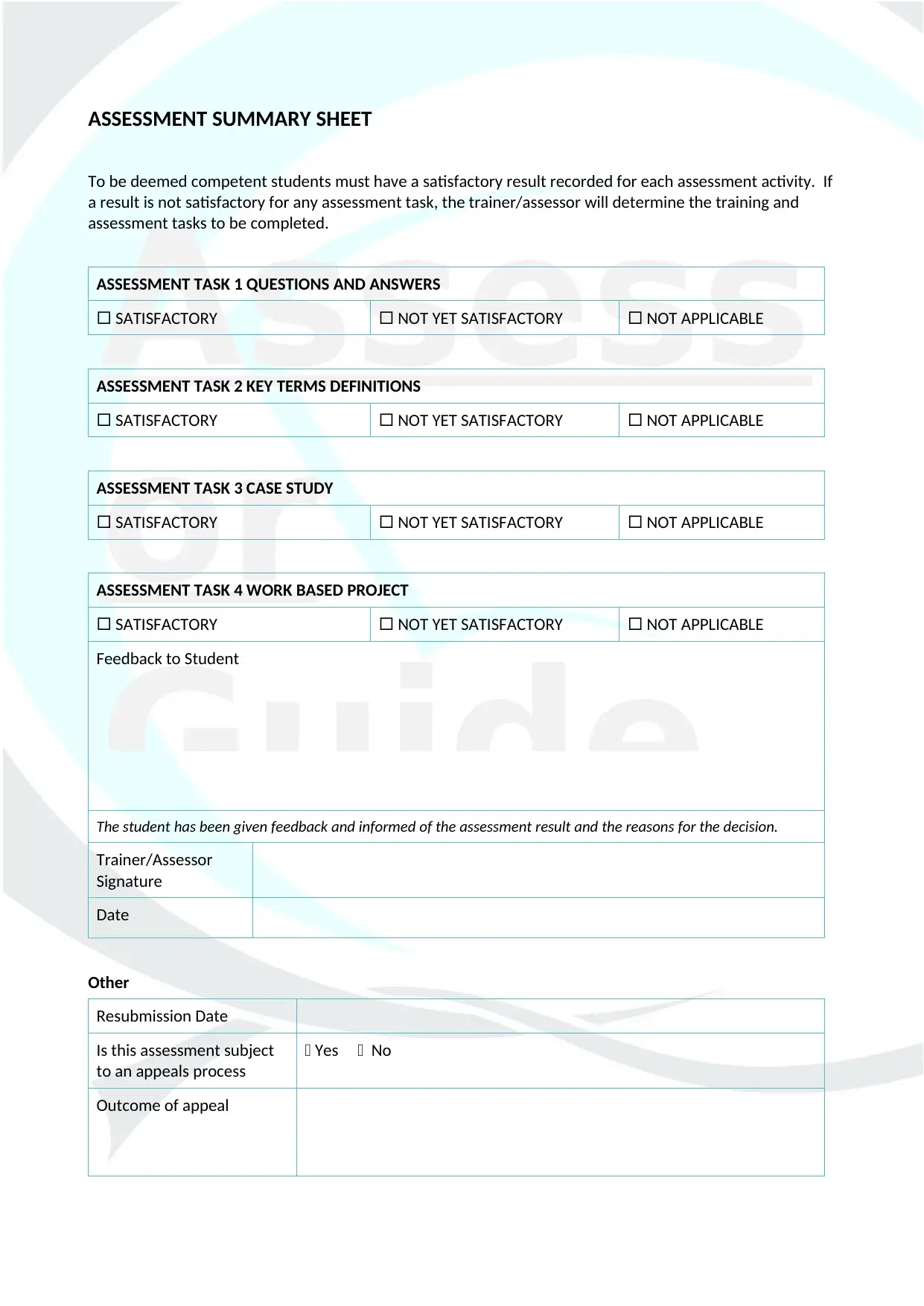
Assess
or
Guide
ASSESSMENT SUMMARY SHEET
To be deemed competent students must have a satisfactory result recorded for each assessment activity. If
a result is not satisfactory for any assessment task, the trainer/assessor will determine the training and
assessment tasks to be completed.
ASSESSMENT TASK 1 QUESTIONS AND ANSWERS
SATISFACTORY NOT YET SATISFACTORY NOT APPLICABLE
ASSESSMENT TASK 2 KEY TERMS DEFINITIONS
SATISFACTORY NOT YET SATISFACTORY NOT APPLICABLE
ASSESSMENT TASK 3 CASE STUDY
SATISFACTORY NOT YET SATISFACTORY NOT APPLICABLE
ASSESSMENT TASK 4 WORK BASED PROJECT
SATISFACTORY NOT YET SATISFACTORY NOT APPLICABLE
Feedback to Student
The student has been given feedback and informed of the assessment result and the reasons for the decision.
Trainer/Assessor
Signature
Date
Other
Resubmission Date
Is this assessment subject
to an appeals process
Yes No
Outcome of appeal
or
Guide
ASSESSMENT SUMMARY SHEET
To be deemed competent students must have a satisfactory result recorded for each assessment activity. If
a result is not satisfactory for any assessment task, the trainer/assessor will determine the training and
assessment tasks to be completed.
ASSESSMENT TASK 1 QUESTIONS AND ANSWERS
SATISFACTORY NOT YET SATISFACTORY NOT APPLICABLE
ASSESSMENT TASK 2 KEY TERMS DEFINITIONS
SATISFACTORY NOT YET SATISFACTORY NOT APPLICABLE
ASSESSMENT TASK 3 CASE STUDY
SATISFACTORY NOT YET SATISFACTORY NOT APPLICABLE
ASSESSMENT TASK 4 WORK BASED PROJECT
SATISFACTORY NOT YET SATISFACTORY NOT APPLICABLE
Feedback to Student
The student has been given feedback and informed of the assessment result and the reasons for the decision.
Trainer/Assessor
Signature
Date
Other
Resubmission Date
Is this assessment subject
to an appeals process
Yes No
Outcome of appeal
⊘ This is a preview!⊘
Do you want full access?
Subscribe today to unlock all pages.

Trusted by 1+ million students worldwide
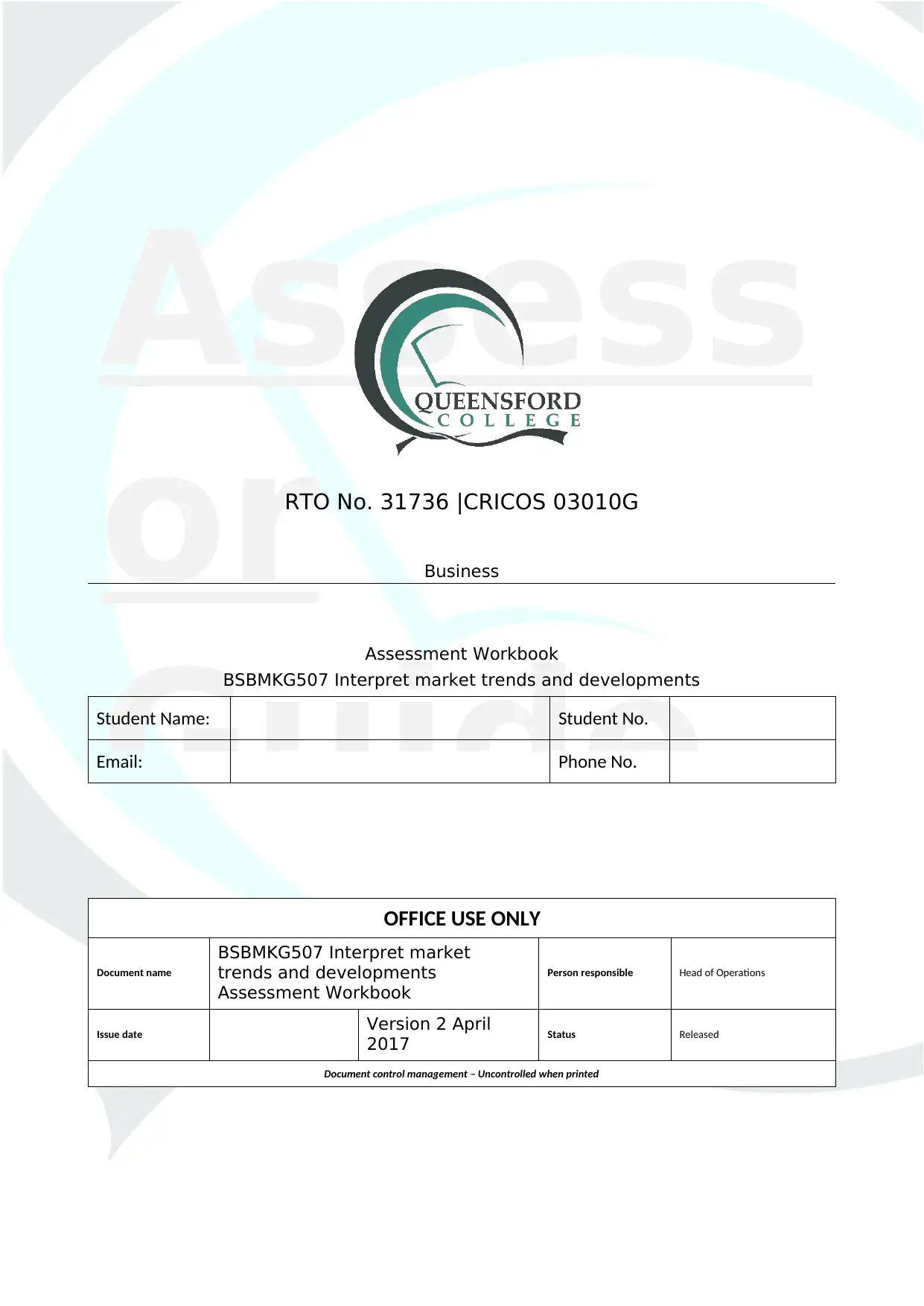
Assess
or
Guide
RTO No. 31736 |CRICOS 03010G
Business
Assessment Workbook
BSBMKG507 Interpret market trends and developments
Student Name: Student No.
Email: Phone No.
OFFICE USE ONLY
Document name
BSBMKG507 Interpret market
trends and developments
Assessment Workbook
Person responsible Head of Operations
Issue date Version 2 April
2017 Status Released
Document control management – Uncontrolled when printed
or
Guide
RTO No. 31736 |CRICOS 03010G
Business
Assessment Workbook
BSBMKG507 Interpret market trends and developments
Student Name: Student No.
Email: Phone No.
OFFICE USE ONLY
Document name
BSBMKG507 Interpret market
trends and developments
Assessment Workbook
Person responsible Head of Operations
Issue date Version 2 April
2017 Status Released
Document control management – Uncontrolled when printed
Paraphrase This Document
Need a fresh take? Get an instant paraphrase of this document with our AI Paraphraser
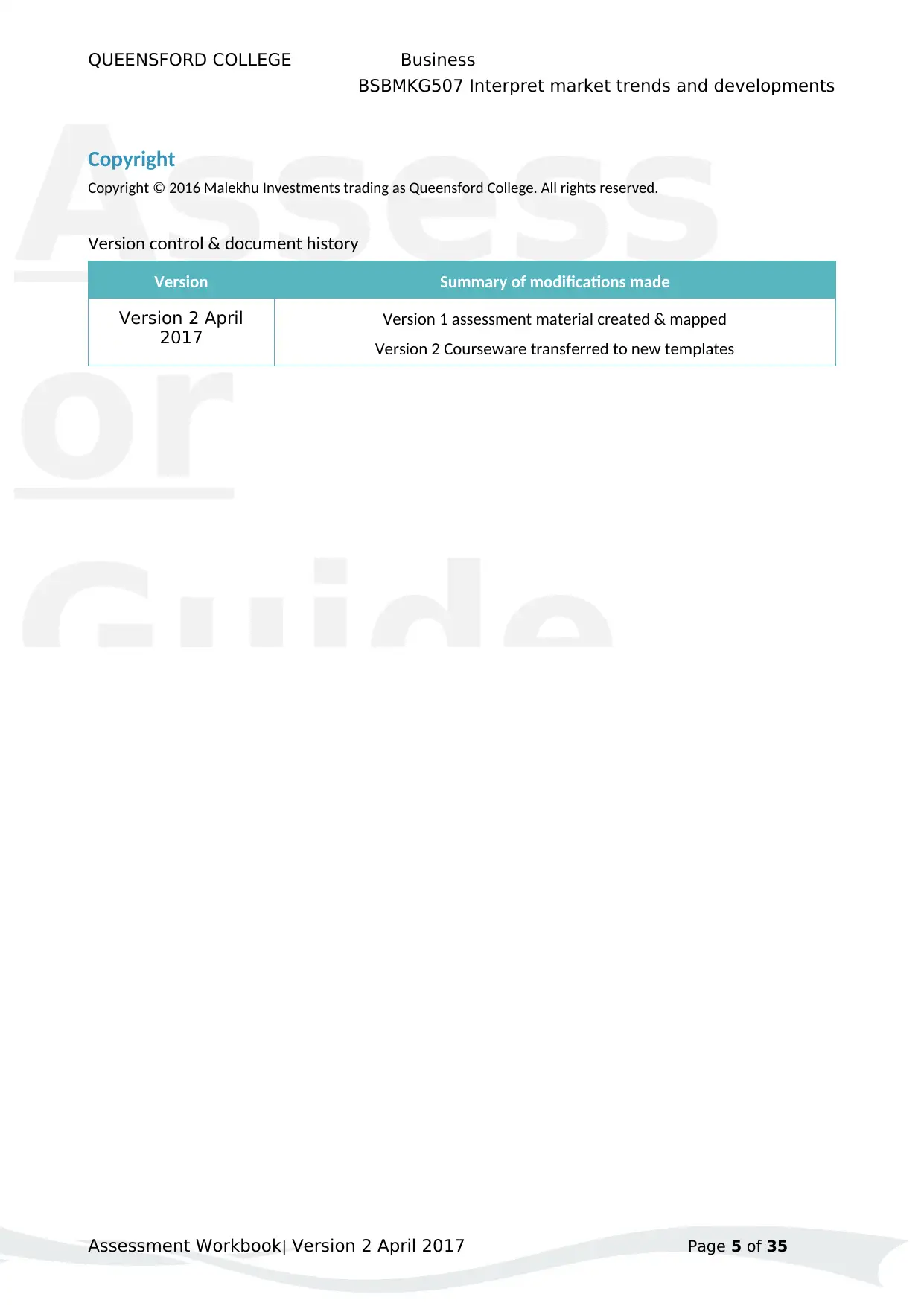
Assess
or
Guide
QUEENSFORD COLLEGE Business
BSBMKG507 Interpret market trends and developments
Copyright
Copyright © 2016 Malekhu Investments trading as Queensford College. All rights reserved.
Version control & document history
Version Summary of modifications made
Version 2 April
2017
Version 1 assessment material created & mapped
Version 2 Courseware transferred to new templates
Assessment Workbook| Version 2 April 2017 Page 5 of 35
or
Guide
QUEENSFORD COLLEGE Business
BSBMKG507 Interpret market trends and developments
Copyright
Copyright © 2016 Malekhu Investments trading as Queensford College. All rights reserved.
Version control & document history
Version Summary of modifications made
Version 2 April
2017
Version 1 assessment material created & mapped
Version 2 Courseware transferred to new templates
Assessment Workbook| Version 2 April 2017 Page 5 of 35
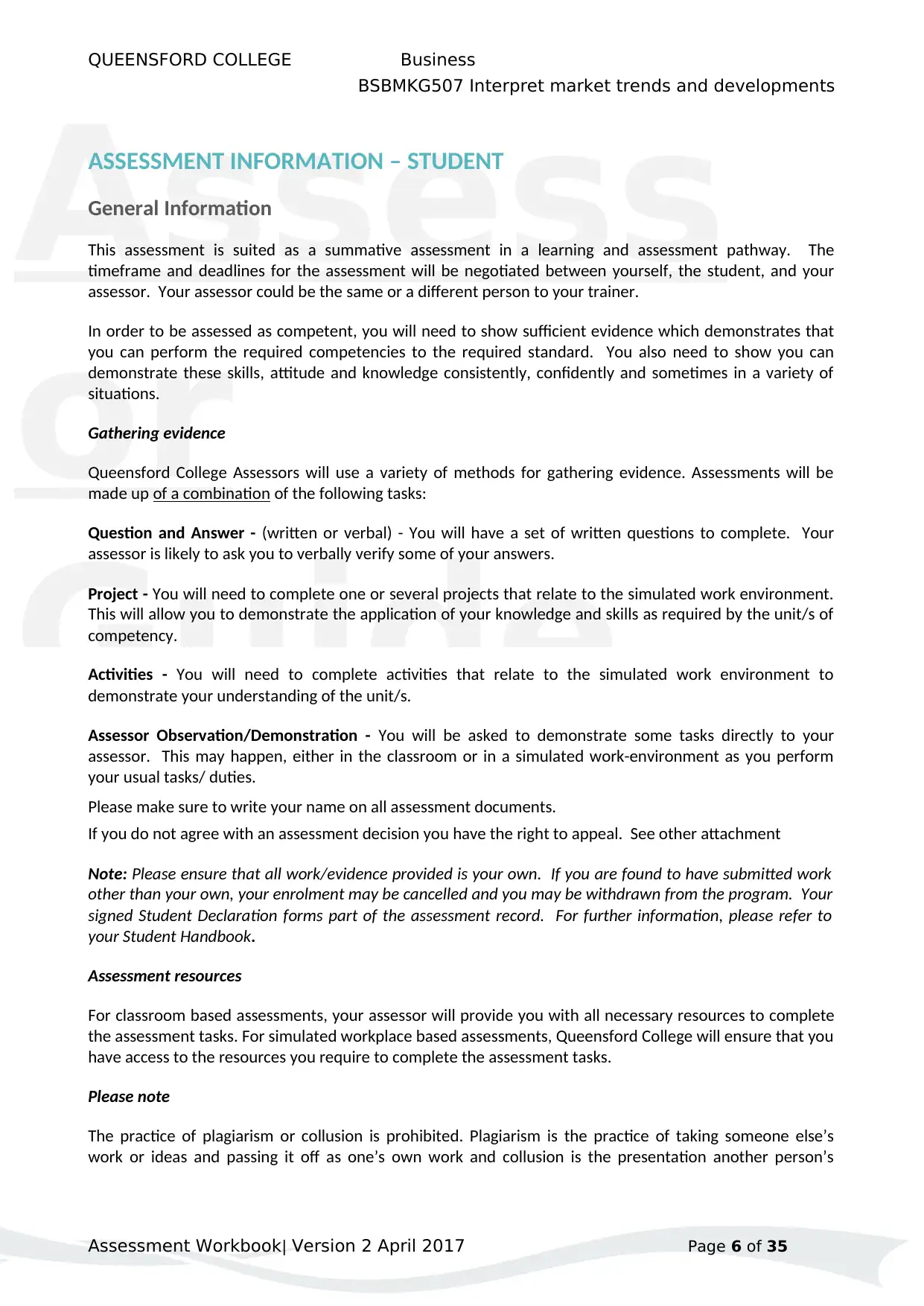
Assess
or
Guide
QUEENSFORD COLLEGE Business
BSBMKG507 Interpret market trends and developments
ASSESSMENT INFORMATION – STUDENT
General Information
This assessment is suited as a summative assessment in a learning and assessment pathway. The
timeframe and deadlines for the assessment will be negotiated between yourself, the student, and your
assessor. Your assessor could be the same or a different person to your trainer.
In order to be assessed as competent, you will need to show sufficient evidence which demonstrates that
you can perform the required competencies to the required standard. You also need to show you can
demonstrate these skills, attitude and knowledge consistently, confidently and sometimes in a variety of
situations.
Gathering evidence
Queensford College Assessors will use a variety of methods for gathering evidence. Assessments will be
made up of a combination of the following tasks:
Question and Answer - (written or verbal) - You will have a set of written questions to complete. Your
assessor is likely to ask you to verbally verify some of your answers.
Project - You will need to complete one or several projects that relate to the simulated work environment.
This will allow you to demonstrate the application of your knowledge and skills as required by the unit/s of
competency.
Activities - You will need to complete activities that relate to the simulated work environment to
demonstrate your understanding of the unit/s.
Assessor Observation/Demonstration - You will be asked to demonstrate some tasks directly to your
assessor. This may happen, either in the classroom or in a simulated work-environment as you perform
your usual tasks/ duties.
Please make sure to write your name on all assessment documents.
If you do not agree with an assessment decision you have the right to appeal. See other attachment
Note: Please ensure that all work/evidence provided is your own. If you are found to have submitted work
other than your own, your enrolment may be cancelled and you may be withdrawn from the program. Your
signed Student Declaration forms part of the assessment record. For further information, please refer to
your Student Handbook.
Assessment resources
For classroom based assessments, your assessor will provide you with all necessary resources to complete
the assessment tasks. For simulated workplace based assessments, Queensford College will ensure that you
have access to the resources you require to complete the assessment tasks.
Please note
The practice of plagiarism or collusion is prohibited. Plagiarism is the practice of taking someone else’s
work or ideas and passing it off as one’s own work and collusion is the presentation another person’s
Assessment Workbook| Version 2 April 2017 Page 6 of 35
or
Guide
QUEENSFORD COLLEGE Business
BSBMKG507 Interpret market trends and developments
ASSESSMENT INFORMATION – STUDENT
General Information
This assessment is suited as a summative assessment in a learning and assessment pathway. The
timeframe and deadlines for the assessment will be negotiated between yourself, the student, and your
assessor. Your assessor could be the same or a different person to your trainer.
In order to be assessed as competent, you will need to show sufficient evidence which demonstrates that
you can perform the required competencies to the required standard. You also need to show you can
demonstrate these skills, attitude and knowledge consistently, confidently and sometimes in a variety of
situations.
Gathering evidence
Queensford College Assessors will use a variety of methods for gathering evidence. Assessments will be
made up of a combination of the following tasks:
Question and Answer - (written or verbal) - You will have a set of written questions to complete. Your
assessor is likely to ask you to verbally verify some of your answers.
Project - You will need to complete one or several projects that relate to the simulated work environment.
This will allow you to demonstrate the application of your knowledge and skills as required by the unit/s of
competency.
Activities - You will need to complete activities that relate to the simulated work environment to
demonstrate your understanding of the unit/s.
Assessor Observation/Demonstration - You will be asked to demonstrate some tasks directly to your
assessor. This may happen, either in the classroom or in a simulated work-environment as you perform
your usual tasks/ duties.
Please make sure to write your name on all assessment documents.
If you do not agree with an assessment decision you have the right to appeal. See other attachment
Note: Please ensure that all work/evidence provided is your own. If you are found to have submitted work
other than your own, your enrolment may be cancelled and you may be withdrawn from the program. Your
signed Student Declaration forms part of the assessment record. For further information, please refer to
your Student Handbook.
Assessment resources
For classroom based assessments, your assessor will provide you with all necessary resources to complete
the assessment tasks. For simulated workplace based assessments, Queensford College will ensure that you
have access to the resources you require to complete the assessment tasks.
Please note
The practice of plagiarism or collusion is prohibited. Plagiarism is the practice of taking someone else’s
work or ideas and passing it off as one’s own work and collusion is the presentation another person’s
Assessment Workbook| Version 2 April 2017 Page 6 of 35
⊘ This is a preview!⊘
Do you want full access?
Subscribe today to unlock all pages.

Trusted by 1+ million students worldwide
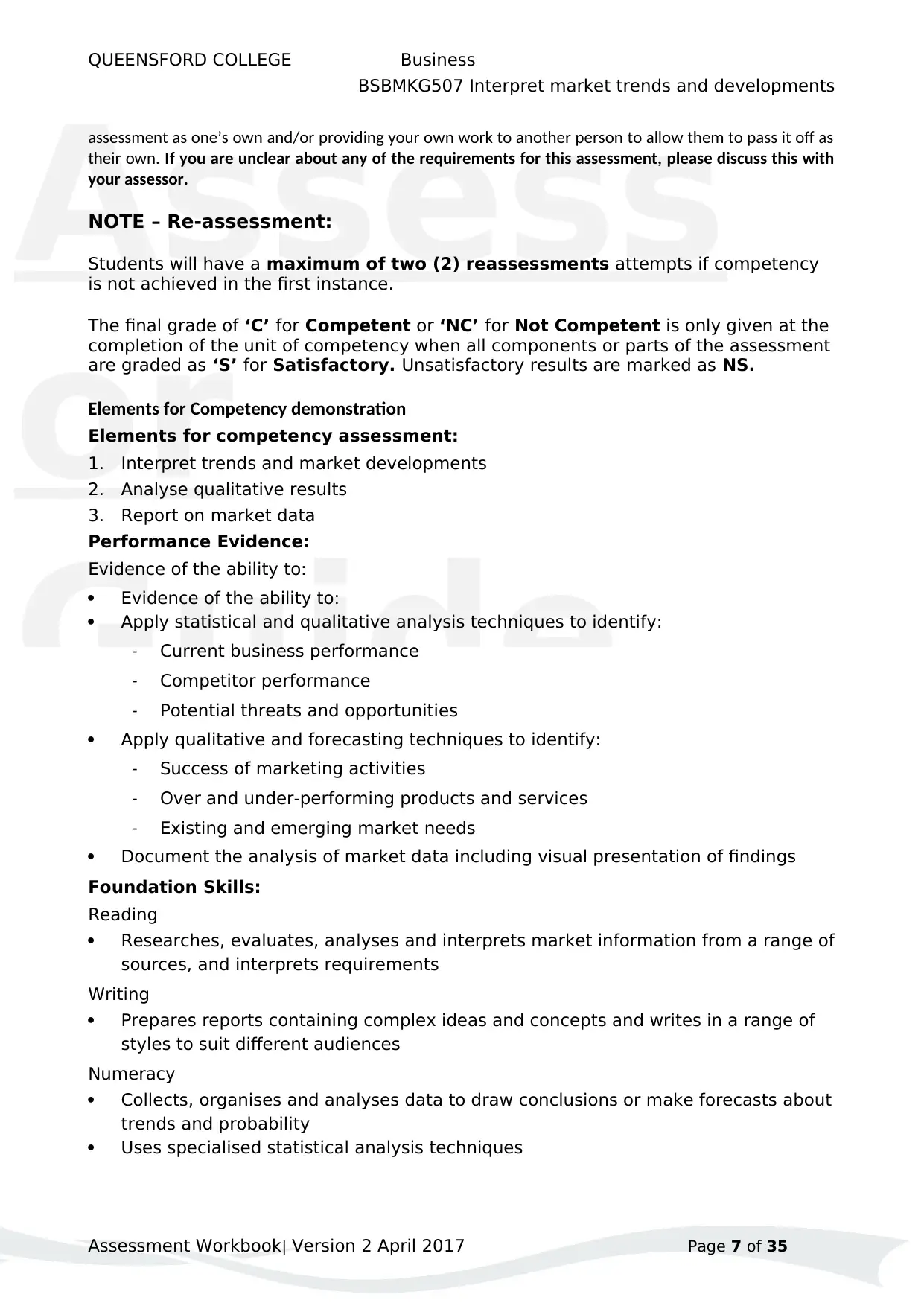
Assess
or
Guide
QUEENSFORD COLLEGE Business
BSBMKG507 Interpret market trends and developments
assessment as one’s own and/or providing your own work to another person to allow them to pass it off as
their own. If you are unclear about any of the requirements for this assessment, please discuss this with
your assessor.
NOTE – Re-assessment:
Students will have a maximum of two (2) reassessments attempts if competency
is not achieved in the first instance.
The final grade of ‘C’ for Competent or ‘NC’ for Not Competent is only given at the
completion of the unit of competency when all components or parts of the assessment
are graded as ‘S’ for Satisfactory. Unsatisfactory results are marked as NS.
Elements for Competency demonstration
Elements for competency assessment:
1. Interpret trends and market developments
2. Analyse qualitative results
3. Report on market data
Performance Evidence:
Evidence of the ability to:
Evidence of the ability to:
Apply statistical and qualitative analysis techniques to identify:
- Current business performance
- Competitor performance
- Potential threats and opportunities
Apply qualitative and forecasting techniques to identify:
- Success of marketing activities
- Over and under-performing products and services
- Existing and emerging market needs
Document the analysis of market data including visual presentation of findings
Foundation Skills:
Reading
Researches, evaluates, analyses and interprets market information from a range of
sources, and interprets requirements
Writing
Prepares reports containing complex ideas and concepts and writes in a range of
styles to suit different audiences
Numeracy
Collects, organises and analyses data to draw conclusions or make forecasts about
trends and probability
Uses specialised statistical analysis techniques
Assessment Workbook| Version 2 April 2017 Page 7 of 35
or
Guide
QUEENSFORD COLLEGE Business
BSBMKG507 Interpret market trends and developments
assessment as one’s own and/or providing your own work to another person to allow them to pass it off as
their own. If you are unclear about any of the requirements for this assessment, please discuss this with
your assessor.
NOTE – Re-assessment:
Students will have a maximum of two (2) reassessments attempts if competency
is not achieved in the first instance.
The final grade of ‘C’ for Competent or ‘NC’ for Not Competent is only given at the
completion of the unit of competency when all components or parts of the assessment
are graded as ‘S’ for Satisfactory. Unsatisfactory results are marked as NS.
Elements for Competency demonstration
Elements for competency assessment:
1. Interpret trends and market developments
2. Analyse qualitative results
3. Report on market data
Performance Evidence:
Evidence of the ability to:
Evidence of the ability to:
Apply statistical and qualitative analysis techniques to identify:
- Current business performance
- Competitor performance
- Potential threats and opportunities
Apply qualitative and forecasting techniques to identify:
- Success of marketing activities
- Over and under-performing products and services
- Existing and emerging market needs
Document the analysis of market data including visual presentation of findings
Foundation Skills:
Reading
Researches, evaluates, analyses and interprets market information from a range of
sources, and interprets requirements
Writing
Prepares reports containing complex ideas and concepts and writes in a range of
styles to suit different audiences
Numeracy
Collects, organises and analyses data to draw conclusions or make forecasts about
trends and probability
Uses specialised statistical analysis techniques
Assessment Workbook| Version 2 April 2017 Page 7 of 35
Paraphrase This Document
Need a fresh take? Get an instant paraphrase of this document with our AI Paraphraser
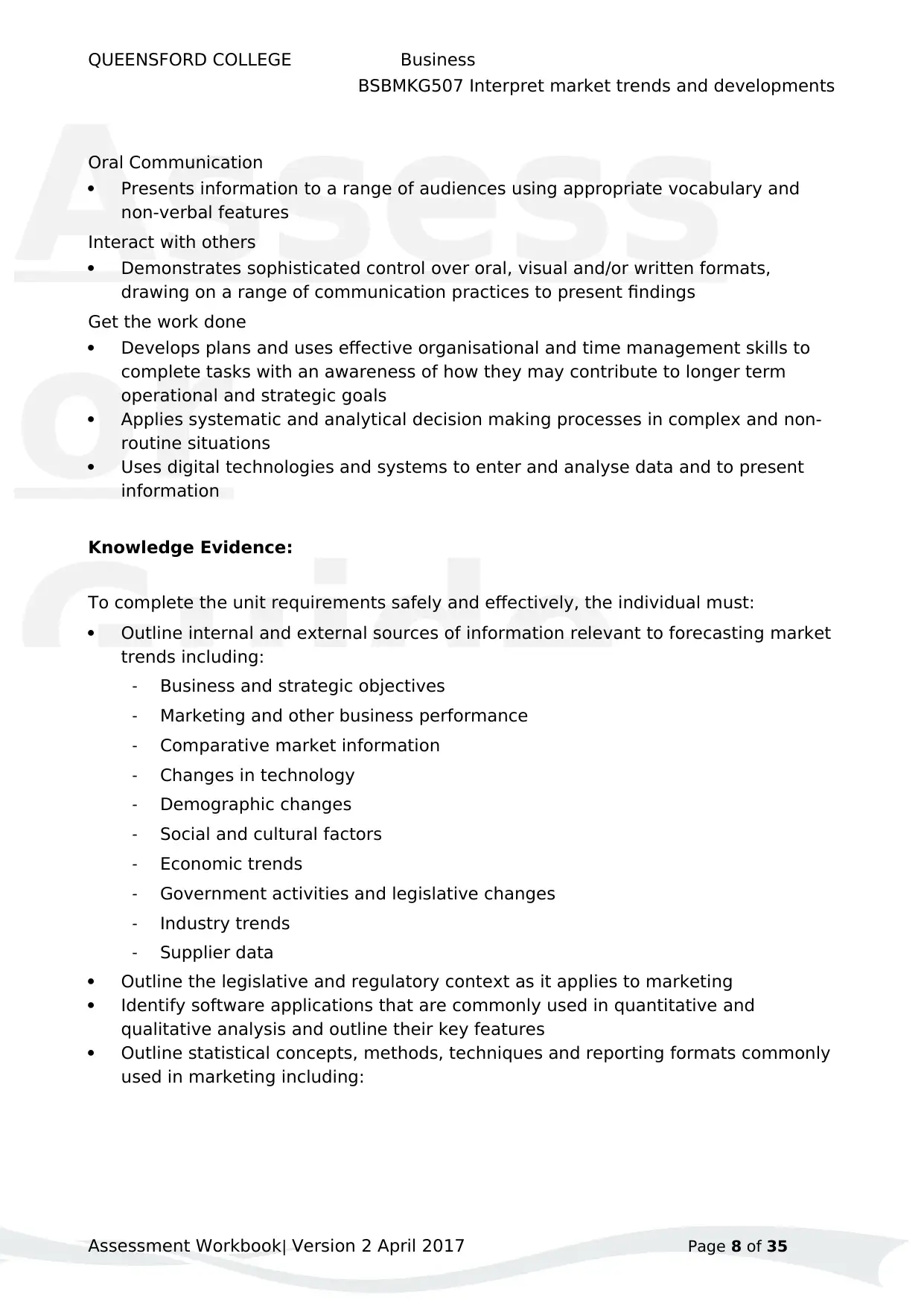
Assess
or
Guide
QUEENSFORD COLLEGE Business
BSBMKG507 Interpret market trends and developments
Oral Communication
Presents information to a range of audiences using appropriate vocabulary and
non-verbal features
Interact with others
Demonstrates sophisticated control over oral, visual and/or written formats,
drawing on a range of communication practices to present findings
Get the work done
Develops plans and uses effective organisational and time management skills to
complete tasks with an awareness of how they may contribute to longer term
operational and strategic goals
Applies systematic and analytical decision making processes in complex and non-
routine situations
Uses digital technologies and systems to enter and analyse data and to present
information
Knowledge Evidence:
To complete the unit requirements safely and effectively, the individual must:
Outline internal and external sources of information relevant to forecasting market
trends including:
- Business and strategic objectives
- Marketing and other business performance
- Comparative market information
- Changes in technology
- Demographic changes
- Social and cultural factors
- Economic trends
- Government activities and legislative changes
- Industry trends
- Supplier data
Outline the legislative and regulatory context as it applies to marketing
Identify software applications that are commonly used in quantitative and
qualitative analysis and outline their key features
Outline statistical concepts, methods, techniques and reporting formats commonly
used in marketing including:
Assessment Workbook| Version 2 April 2017 Page 8 of 35
or
Guide
QUEENSFORD COLLEGE Business
BSBMKG507 Interpret market trends and developments
Oral Communication
Presents information to a range of audiences using appropriate vocabulary and
non-verbal features
Interact with others
Demonstrates sophisticated control over oral, visual and/or written formats,
drawing on a range of communication practices to present findings
Get the work done
Develops plans and uses effective organisational and time management skills to
complete tasks with an awareness of how they may contribute to longer term
operational and strategic goals
Applies systematic and analytical decision making processes in complex and non-
routine situations
Uses digital technologies and systems to enter and analyse data and to present
information
Knowledge Evidence:
To complete the unit requirements safely and effectively, the individual must:
Outline internal and external sources of information relevant to forecasting market
trends including:
- Business and strategic objectives
- Marketing and other business performance
- Comparative market information
- Changes in technology
- Demographic changes
- Social and cultural factors
- Economic trends
- Government activities and legislative changes
- Industry trends
- Supplier data
Outline the legislative and regulatory context as it applies to marketing
Identify software applications that are commonly used in quantitative and
qualitative analysis and outline their key features
Outline statistical concepts, methods, techniques and reporting formats commonly
used in marketing including:
Assessment Workbook| Version 2 April 2017 Page 8 of 35
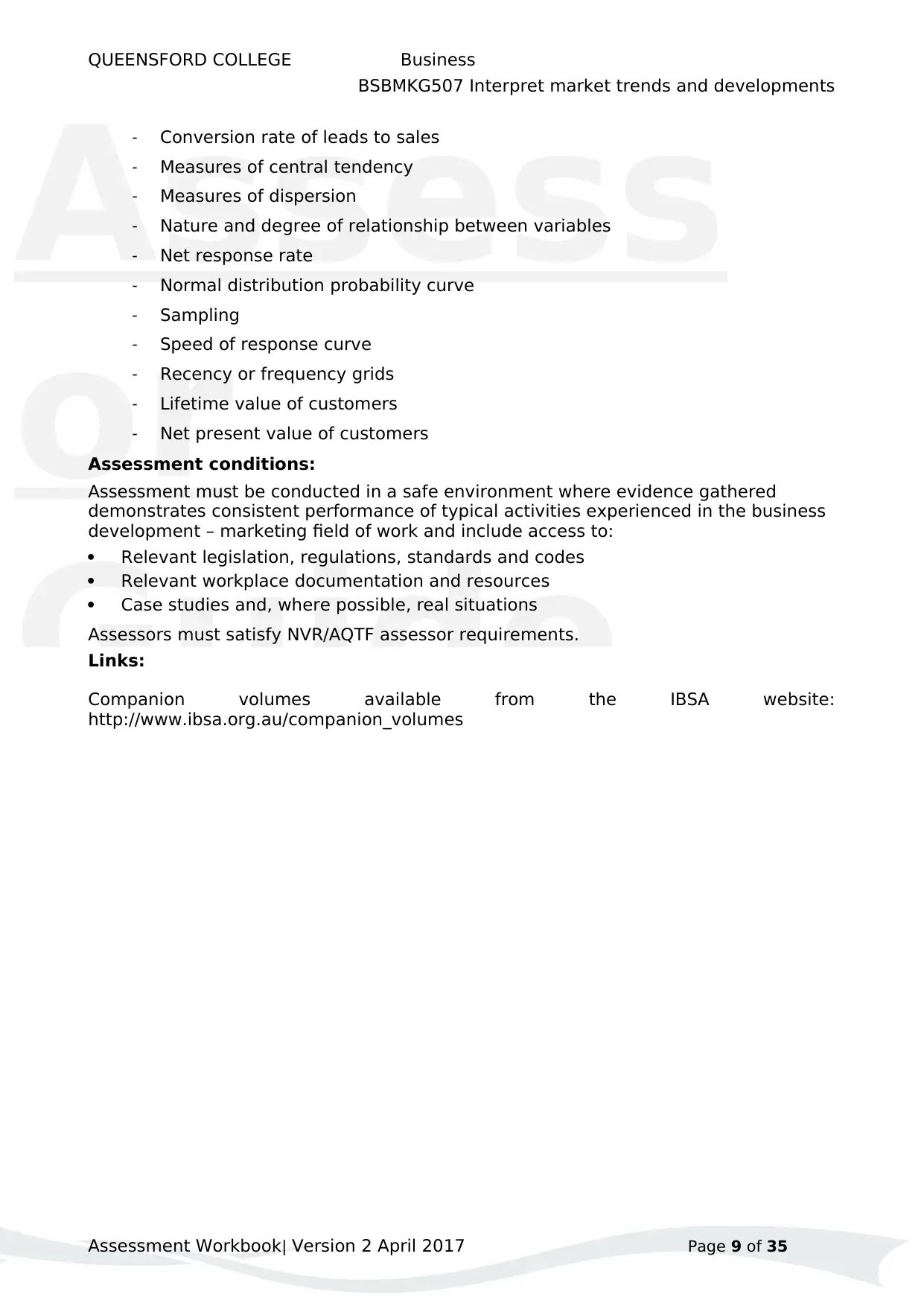
Assess
or
Guide
QUEENSFORD COLLEGE Business
BSBMKG507 Interpret market trends and developments
- Conversion rate of leads to sales
- Measures of central tendency
- Measures of dispersion
- Nature and degree of relationship between variables
- Net response rate
- Normal distribution probability curve
- Sampling
- Speed of response curve
- Recency or frequency grids
- Lifetime value of customers
- Net present value of customers
Assessment conditions:
Assessment must be conducted in a safe environment where evidence gathered
demonstrates consistent performance of typical activities experienced in the business
development – marketing field of work and include access to:
Relevant legislation, regulations, standards and codes
Relevant workplace documentation and resources
Case studies and, where possible, real situations
Assessors must satisfy NVR/AQTF assessor requirements.
Links:
Companion volumes available from the IBSA website:
http://www.ibsa.org.au/companion_volumes
Assessment Workbook| Version 2 April 2017 Page 9 of 35
or
Guide
QUEENSFORD COLLEGE Business
BSBMKG507 Interpret market trends and developments
- Conversion rate of leads to sales
- Measures of central tendency
- Measures of dispersion
- Nature and degree of relationship between variables
- Net response rate
- Normal distribution probability curve
- Sampling
- Speed of response curve
- Recency or frequency grids
- Lifetime value of customers
- Net present value of customers
Assessment conditions:
Assessment must be conducted in a safe environment where evidence gathered
demonstrates consistent performance of typical activities experienced in the business
development – marketing field of work and include access to:
Relevant legislation, regulations, standards and codes
Relevant workplace documentation and resources
Case studies and, where possible, real situations
Assessors must satisfy NVR/AQTF assessor requirements.
Links:
Companion volumes available from the IBSA website:
http://www.ibsa.org.au/companion_volumes
Assessment Workbook| Version 2 April 2017 Page 9 of 35
⊘ This is a preview!⊘
Do you want full access?
Subscribe today to unlock all pages.

Trusted by 1+ million students worldwide
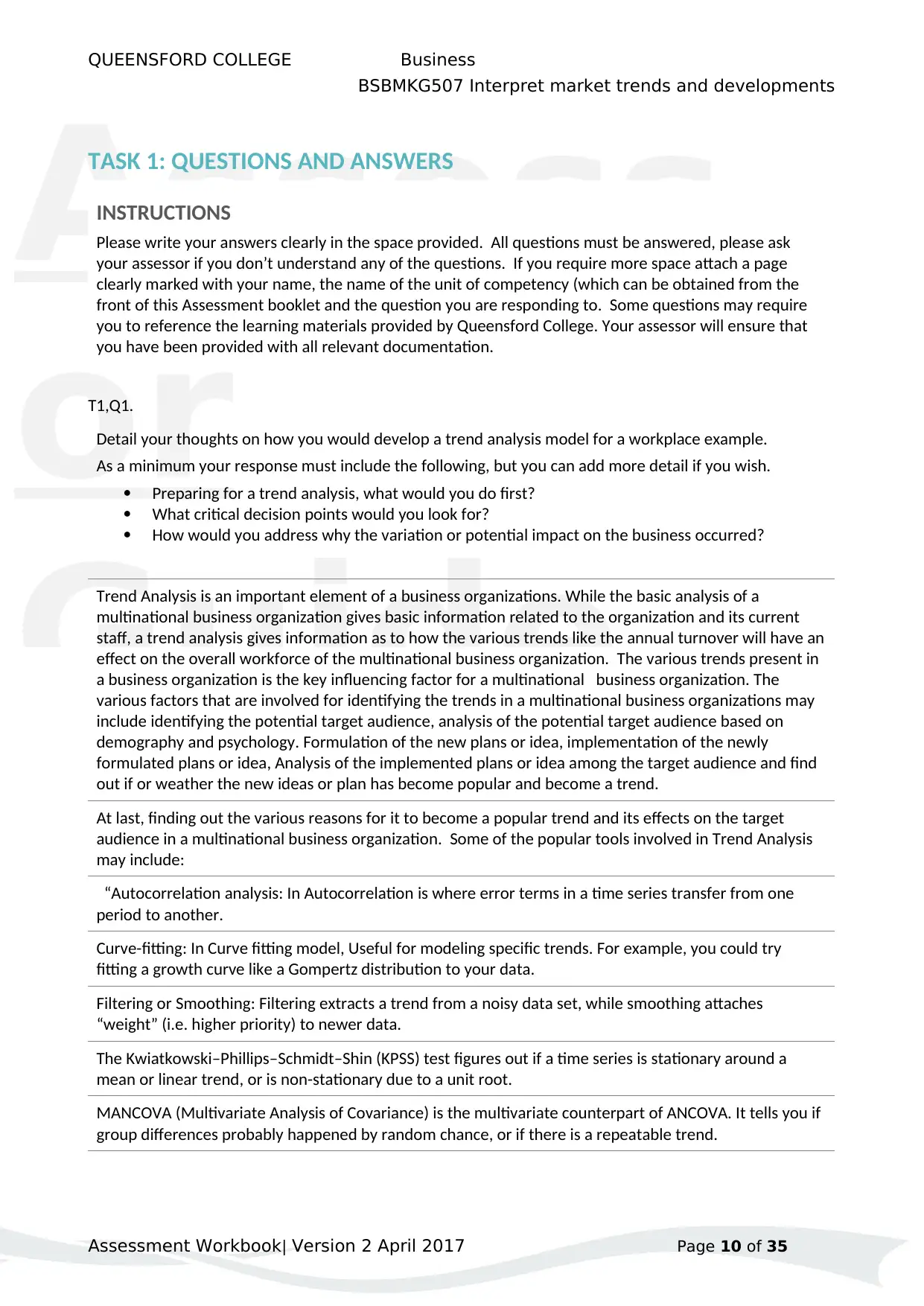
Assess
or
Guide
QUEENSFORD COLLEGE Business
BSBMKG507 Interpret market trends and developments
TASK 1: QUESTIONS AND ANSWERS
INSTRUCTIONS
Please write your answers clearly in the space provided. All questions must be answered, please ask
your assessor if you don’t understand any of the questions. If you require more space attach a page
clearly marked with your name, the name of the unit of competency (which can be obtained from the
front of this Assessment booklet and the question you are responding to. Some questions may require
you to reference the learning materials provided by Queensford College. Your assessor will ensure that
you have been provided with all relevant documentation.
T1,Q1.
Detail your thoughts on how you would develop a trend analysis model for a workplace example.
As a minimum your response must include the following, but you can add more detail if you wish.
Preparing for a trend analysis, what would you do first?
What critical decision points would you look for?
How would you address why the variation or potential impact on the business occurred?
Trend Analysis is an important element of a business organizations. While the basic analysis of a
multinational business organization gives basic information related to the organization and its current
staff, a trend analysis gives information as to how the various trends like the annual turnover will have an
effect on the overall workforce of the multinational business organization. The various trends present in
a business organization is the key influencing factor for a multinational business organization. The
various factors that are involved for identifying the trends in a multinational business organizations may
include identifying the potential target audience, analysis of the potential target audience based on
demography and psychology. Formulation of the new plans or idea, implementation of the newly
formulated plans or idea, Analysis of the implemented plans or idea among the target audience and find
out if or weather the new ideas or plan has become popular and become a trend.
At last, finding out the various reasons for it to become a popular trend and its effects on the target
audience in a multinational business organization. Some of the popular tools involved in Trend Analysis
may include:
“Autocorrelation analysis: In Autocorrelation is where error terms in a time series transfer from one
period to another.
Curve-fitting: In Curve fitting model, Useful for modeling specific trends. For example, you could try
fitting a growth curve like a Gompertz distribution to your data.
Filtering or Smoothing: Filtering extracts a trend from a noisy data set, while smoothing attaches
“weight” (i.e. higher priority) to newer data.
The Kwiatkowski–Phillips–Schmidt–Shin (KPSS) test figures out if a time series is stationary around a
mean or linear trend, or is non-stationary due to a unit root.
MANCOVA (Multivariate Analysis of Covariance) is the multivariate counterpart of ANCOVA. It tells you if
group differences probably happened by random chance, or if there is a repeatable trend.
Assessment Workbook| Version 2 April 2017 Page 10 of 35
or
Guide
QUEENSFORD COLLEGE Business
BSBMKG507 Interpret market trends and developments
TASK 1: QUESTIONS AND ANSWERS
INSTRUCTIONS
Please write your answers clearly in the space provided. All questions must be answered, please ask
your assessor if you don’t understand any of the questions. If you require more space attach a page
clearly marked with your name, the name of the unit of competency (which can be obtained from the
front of this Assessment booklet and the question you are responding to. Some questions may require
you to reference the learning materials provided by Queensford College. Your assessor will ensure that
you have been provided with all relevant documentation.
T1,Q1.
Detail your thoughts on how you would develop a trend analysis model for a workplace example.
As a minimum your response must include the following, but you can add more detail if you wish.
Preparing for a trend analysis, what would you do first?
What critical decision points would you look for?
How would you address why the variation or potential impact on the business occurred?
Trend Analysis is an important element of a business organizations. While the basic analysis of a
multinational business organization gives basic information related to the organization and its current
staff, a trend analysis gives information as to how the various trends like the annual turnover will have an
effect on the overall workforce of the multinational business organization. The various trends present in
a business organization is the key influencing factor for a multinational business organization. The
various factors that are involved for identifying the trends in a multinational business organizations may
include identifying the potential target audience, analysis of the potential target audience based on
demography and psychology. Formulation of the new plans or idea, implementation of the newly
formulated plans or idea, Analysis of the implemented plans or idea among the target audience and find
out if or weather the new ideas or plan has become popular and become a trend.
At last, finding out the various reasons for it to become a popular trend and its effects on the target
audience in a multinational business organization. Some of the popular tools involved in Trend Analysis
may include:
“Autocorrelation analysis: In Autocorrelation is where error terms in a time series transfer from one
period to another.
Curve-fitting: In Curve fitting model, Useful for modeling specific trends. For example, you could try
fitting a growth curve like a Gompertz distribution to your data.
Filtering or Smoothing: Filtering extracts a trend from a noisy data set, while smoothing attaches
“weight” (i.e. higher priority) to newer data.
The Kwiatkowski–Phillips–Schmidt–Shin (KPSS) test figures out if a time series is stationary around a
mean or linear trend, or is non-stationary due to a unit root.
MANCOVA (Multivariate Analysis of Covariance) is the multivariate counterpart of ANCOVA. It tells you if
group differences probably happened by random chance, or if there is a repeatable trend.
Assessment Workbook| Version 2 April 2017 Page 10 of 35
Paraphrase This Document
Need a fresh take? Get an instant paraphrase of this document with our AI Paraphraser
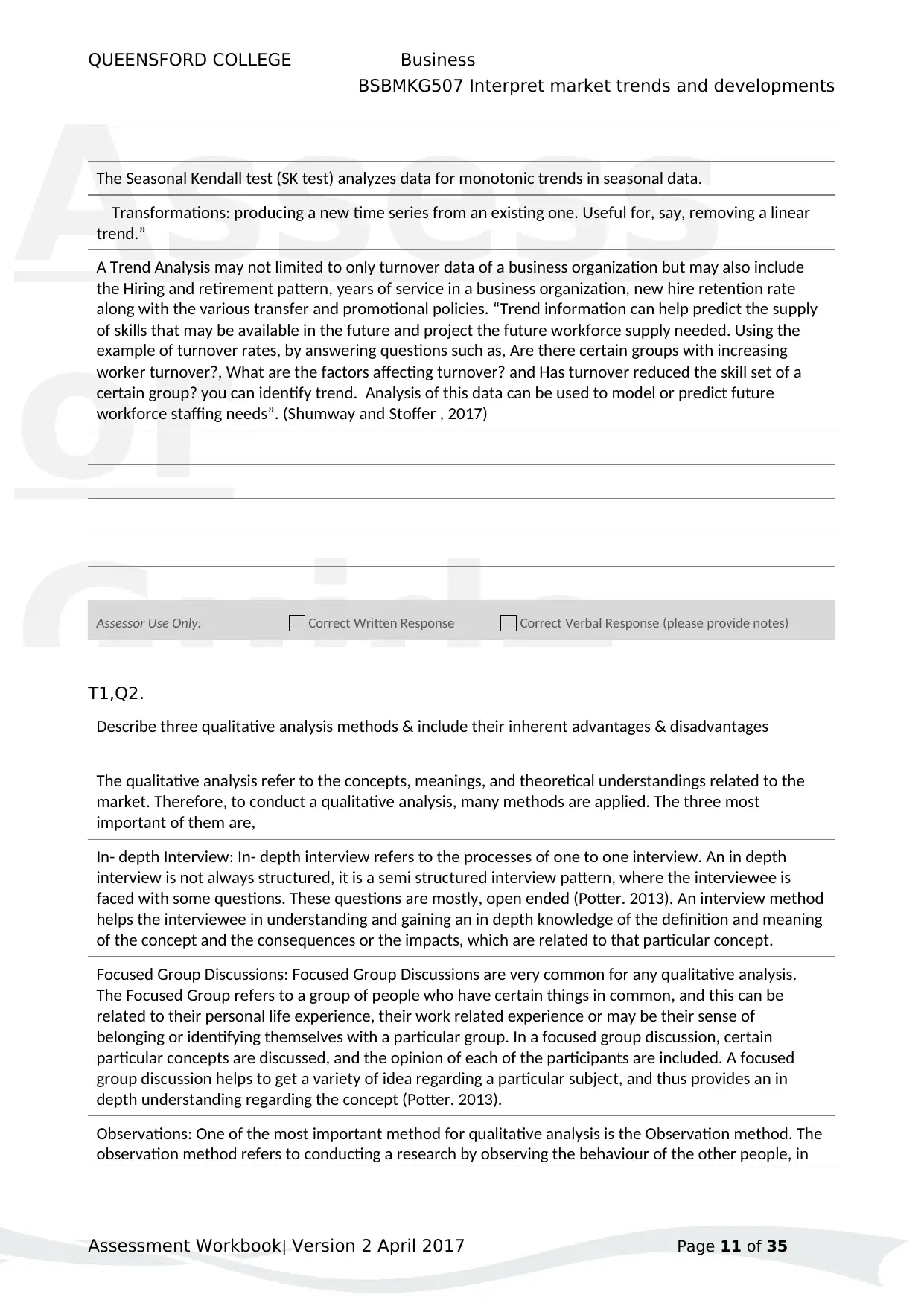
Assess
or
Guide
QUEENSFORD COLLEGE Business
BSBMKG507 Interpret market trends and developments
The Seasonal Kendall test (SK test) analyzes data for monotonic trends in seasonal data.
Transformations: producing a new time series from an existing one. Useful for, say, removing a linear
trend.”
A Trend Analysis may not limited to only turnover data of a business organization but may also include
the Hiring and retirement pattern, years of service in a business organization, new hire retention rate
along with the various transfer and promotional policies. “Trend information can help predict the supply
of skills that may be available in the future and project the future workforce supply needed. Using the
example of turnover rates, by answering questions such as, Are there certain groups with increasing
worker turnover?, What are the factors affecting turnover? and Has turnover reduced the skill set of a
certain group? you can identify trend. Analysis of this data can be used to model or predict future
workforce staffing needs”. (Shumway and Stoffer , 2017)
Assessor Use Only: Correct Written Response Correct Verbal Response (please provide notes)
T1,Q2.
Describe three qualitative analysis methods & include their inherent advantages & disadvantages
The qualitative analysis refer to the concepts, meanings, and theoretical understandings related to the
market. Therefore, to conduct a qualitative analysis, many methods are applied. The three most
important of them are,
In- depth Interview: In- depth interview refers to the processes of one to one interview. An in depth
interview is not always structured, it is a semi structured interview pattern, where the interviewee is
faced with some questions. These questions are mostly, open ended (Potter. 2013). An interview method
helps the interviewee in understanding and gaining an in depth knowledge of the definition and meaning
of the concept and the consequences or the impacts, which are related to that particular concept.
Focused Group Discussions: Focused Group Discussions are very common for any qualitative analysis.
The Focused Group refers to a group of people who have certain things in common, and this can be
related to their personal life experience, their work related experience or may be their sense of
belonging or identifying themselves with a particular group. In a focused group discussion, certain
particular concepts are discussed, and the opinion of each of the participants are included. A focused
group discussion helps to get a variety of idea regarding a particular subject, and thus provides an in
depth understanding regarding the concept (Potter. 2013).
Observations: One of the most important method for qualitative analysis is the Observation method. The
observation method refers to conducting a research by observing the behaviour of the other people, in
Assessment Workbook| Version 2 April 2017 Page 11 of 35
or
Guide
QUEENSFORD COLLEGE Business
BSBMKG507 Interpret market trends and developments
The Seasonal Kendall test (SK test) analyzes data for monotonic trends in seasonal data.
Transformations: producing a new time series from an existing one. Useful for, say, removing a linear
trend.”
A Trend Analysis may not limited to only turnover data of a business organization but may also include
the Hiring and retirement pattern, years of service in a business organization, new hire retention rate
along with the various transfer and promotional policies. “Trend information can help predict the supply
of skills that may be available in the future and project the future workforce supply needed. Using the
example of turnover rates, by answering questions such as, Are there certain groups with increasing
worker turnover?, What are the factors affecting turnover? and Has turnover reduced the skill set of a
certain group? you can identify trend. Analysis of this data can be used to model or predict future
workforce staffing needs”. (Shumway and Stoffer , 2017)
Assessor Use Only: Correct Written Response Correct Verbal Response (please provide notes)
T1,Q2.
Describe three qualitative analysis methods & include their inherent advantages & disadvantages
The qualitative analysis refer to the concepts, meanings, and theoretical understandings related to the
market. Therefore, to conduct a qualitative analysis, many methods are applied. The three most
important of them are,
In- depth Interview: In- depth interview refers to the processes of one to one interview. An in depth
interview is not always structured, it is a semi structured interview pattern, where the interviewee is
faced with some questions. These questions are mostly, open ended (Potter. 2013). An interview method
helps the interviewee in understanding and gaining an in depth knowledge of the definition and meaning
of the concept and the consequences or the impacts, which are related to that particular concept.
Focused Group Discussions: Focused Group Discussions are very common for any qualitative analysis.
The Focused Group refers to a group of people who have certain things in common, and this can be
related to their personal life experience, their work related experience or may be their sense of
belonging or identifying themselves with a particular group. In a focused group discussion, certain
particular concepts are discussed, and the opinion of each of the participants are included. A focused
group discussion helps to get a variety of idea regarding a particular subject, and thus provides an in
depth understanding regarding the concept (Potter. 2013).
Observations: One of the most important method for qualitative analysis is the Observation method. The
observation method refers to conducting a research by observing the behaviour of the other people, in
Assessment Workbook| Version 2 April 2017 Page 11 of 35
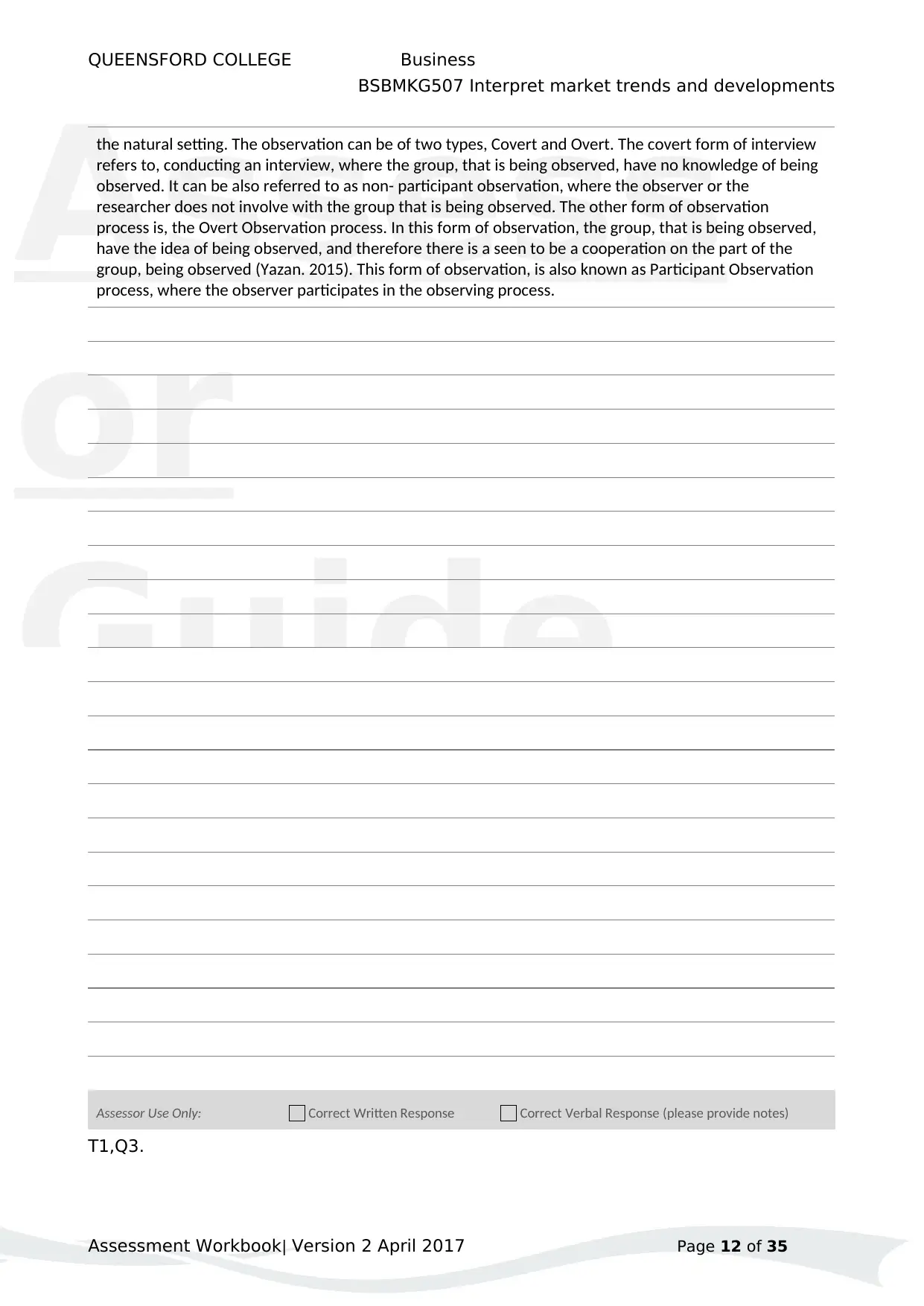
Assess
or
Guide
QUEENSFORD COLLEGE Business
BSBMKG507 Interpret market trends and developments
the natural setting. The observation can be of two types, Covert and Overt. The covert form of interview
refers to, conducting an interview, where the group, that is being observed, have no knowledge of being
observed. It can be also referred to as non- participant observation, where the observer or the
researcher does not involve with the group that is being observed. The other form of observation
process is, the Overt Observation process. In this form of observation, the group, that is being observed,
have the idea of being observed, and therefore there is a seen to be a cooperation on the part of the
group, being observed (Yazan. 2015). This form of observation, is also known as Participant Observation
process, where the observer participates in the observing process.
Assessor Use Only: Correct Written Response Correct Verbal Response (please provide notes)
T1,Q3.
Assessment Workbook| Version 2 April 2017 Page 12 of 35
or
Guide
QUEENSFORD COLLEGE Business
BSBMKG507 Interpret market trends and developments
the natural setting. The observation can be of two types, Covert and Overt. The covert form of interview
refers to, conducting an interview, where the group, that is being observed, have no knowledge of being
observed. It can be also referred to as non- participant observation, where the observer or the
researcher does not involve with the group that is being observed. The other form of observation
process is, the Overt Observation process. In this form of observation, the group, that is being observed,
have the idea of being observed, and therefore there is a seen to be a cooperation on the part of the
group, being observed (Yazan. 2015). This form of observation, is also known as Participant Observation
process, where the observer participates in the observing process.
Assessor Use Only: Correct Written Response Correct Verbal Response (please provide notes)
T1,Q3.
Assessment Workbook| Version 2 April 2017 Page 12 of 35
⊘ This is a preview!⊘
Do you want full access?
Subscribe today to unlock all pages.

Trusted by 1+ million students worldwide
1 out of 34
Related Documents
Your All-in-One AI-Powered Toolkit for Academic Success.
+13062052269
info@desklib.com
Available 24*7 on WhatsApp / Email
![[object Object]](/_next/static/media/star-bottom.7253800d.svg)
Unlock your academic potential
Copyright © 2020–2025 A2Z Services. All Rights Reserved. Developed and managed by ZUCOL.





